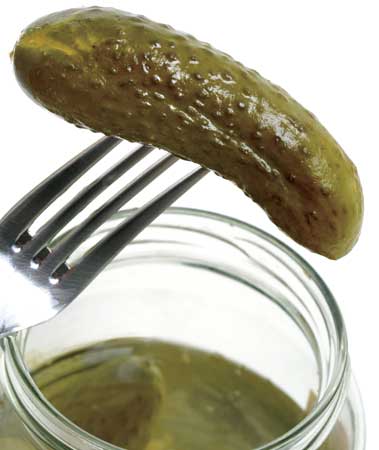Reactions to PHO ban; Soil microbe combats arsenic in rice
NEWS
 Reducing pickles’ environmental impact
Reducing pickles’ environmental impact
Pickled vegetables are popular among consumers, particularly pickled cucumbers. These pickles, however, are traditionally brined in high-salt solutions, and treating leftover brine can be a challenge for processors. In a recent study that appeared in the Journal of Food Science, researchers examined whether consumers would accept pickled cucumbers that were brined instead in a calcium chloride (CaCl2) solution, which does not pose the same environmental problem as sodium chloride (NaCl) in plant waste waters.
In the study, the researchers fermented and stored cucumbers with a molarity of 0.1 CaCl2 or 1 NaCl in open-air, 3,000-gallon tanks and processed them into hamburger dill chips containing a molarity of 0.38 NaCl. A sample of about 100 tasters showed no significant preference for pickles from either treatment method when stored for two or eight months, but they did prefer pickles made with NaCl when both were stored for 10 months. According to the study, consumers preferred these pickles not because they preferred the taste but because there were textural issues associated with the pickles made with CaCl2. The authors conclude that further process optimization is needed to combat these textural issues, but they see potential for CaCl2 use in pickle manufacturing.
Reactions to PHO ban
On June 16, the U.S. Food and Drug Administration (FDA) revoked the Generally Recognized as Safe status of partially hydrogenated oils (PHOs), instructing that companies must remove this controversial ingredient from most food products within the next three years. In anticipation of this decision, many food companies had already begun phasing out PHOs, which are the primary dietary source of artificial trans fat in processed foods.
“The FDA’s action on this major source of artificial trans fat demonstrates the agency’s commitment to the heart health of all Americans,” says FDA’s Acting Commissioner Stephen Ostroff on the FDA’s blog. “This action is expected to reduce coronary heart disease and prevent thousands of fatal heart attacks every year.”
In addition to banning PHOs, the decision provides a firm definition of fully hydrogenated oil, which is not banned. This is important, says Richard Galloway, a QUALISOY consultant and expert in the oil refining industry, because it means that formulators have the option of replacing PHOs with interesterified fully hydrogenated oil or blending fully hydrogenated oil with liquid oil.
Soil microbe combats arsenic in rice
A soil microbe discovered by researchers from the University of Delaware has been found to prevent arsenic uptake in rice plants, according to an article published in Planta.
Rice plants take up arsenic as they absorb phosphate, which has a similar chemical structure, and because rice is grown underwater, it takes in 10 times more arsenic than other cereal grains. The soil bacteria, EA106, can mobilize iron and form a plaque on the roots’ surface that prevents arsenic from entering the plant. By treating hundreds of rice plants with the microbe, the researchers improved iron uptake at the roots and reduced arsenic accumulation in the plant shoots.
The researchers are still exploring ways to potentially treat seeds with the microbe before planting. “We’re not all the way to the grain level yet,” says Harsh Blais, the study’s leader. “We are working on that now, to see if EA106 prevents arsenic accumulation in the grain. That is the ultimate test.”
USDA report highlights new technologies
The U.S. Dept. of Agriculture (USDA) released its 2014 Annual Report on Technology transfer, which highlighted discoveries by USDA researchers that show potential for commercial application and economic growth. In the areas of food and nutrition, these include procedures to remove up to 98% of allergens from peanuts, an egg-pasteurization process using radiofrequency energy that is 1.5 times faster than the one currently used, and a portable method for identifying harmful bacteria in food that could improve the response to outbreaks of foodborne illnesses.
Other notable breakthroughs include the development of self-drying raisins, extending frying oil shelf life by adding antioxidants, and identifying genetic variation in rainbow trout that could produce higher levels of omega-3s. In addition, researchers established that the use of antibiotics in cattle feedlots does not lead to increases in antibiotic-resistant E. coli.
“USDA research plays a dual role in the protection of agriculture and public health, producing science-based answers for decision-making,” says Catherine Woteki, USDA undersecretary for research, education, and economics. “We bring together expertise from animal science, veterinary medicine, food safety, nutrition, wildlife, plant science, economics, ecology, biotechnology, and other agricultural and health disciplines to set priorities for our research programs. And we’re proud of the contributions our research has made in developing new products and technologies that benefit producers, consumers, and the environment.”
 Researchers pinpoint soybean seed gene
Researchers pinpoint soybean seed gene
A team of Purdue University researchers identified the gene that determines whether a soybean seed develops a hard or permeable coat, according to findings published in Nature Genetics. This discovery shows potential for developing varieties more suited to tropical and southern regions while enriching soybeans’ genetic diversity.
Mutations in the gene, called GmHs1-1, allow soybean seeds’ tough coats to become permeable, which proved an advantage 5,000 years ago when the crop was being domesticated. However, in some places, that permeability is now a disadvantage, as permeable seeds are not as protected from severe conditions and inhospitable environments. Hard coatings, on the other hand, allow seeds to retain their viability for extended time periods.
In addition, the gene is associated with soybeans’ calcium content, and the team sees potential for tapping into the gene to improve the nutrition of soy food products. They also believe the discovery could improve the cooking process for soybeans and other legumes, as variations in seed hardness make it difficult to achieve consistent quality in cooked beans.
What’s new with food companies
• The Almond Board of California announced a $2.5 million dollar commitment to independent, third-party research into water efficiency, bee health, and environmentally and socially responsible farming practices.
• Brookfield Engineering donated a powder flow tester to the new Kansas State University Bulk Solids Innovation Center.
• Campbell Soup Co. will acquire the assets and business of Garden Fresh Gourmet, which makes refrigerated salsa, hummus, dips, and tortilla chips.
• Clif Bar & Co. and Organic Valley named the University of Wisconsin–Madison recipient of the nation’s first endowed chair focused on plant breeding for organic crops. In addition, Clif is working with other organizations to raise $10 million by 2020 to fund other chairs dedicated to organic plant breeding.
• The North American headquarters building of Dole Packaged Foods was awarded LEED Gold Certification.
• FONA International was named one of Chicago’s 101 Best and Brightest Companies to Work For by the National Association for Business Resources for the 10th year in a row.
• Frutarom acquired Australian company Taura Natural Ingredients Holding.
• Fuchs North America, a supplier of seasonings, flavor systems, and taste solutions to the food manufacturing and foodservice industries, opened its new headquarters in Hampstead, Md.
• General Mills announced that it will remove artificial flavors and colors from artificial sources from the roughly 40% of its cereals that still contain these ingredients.
• Hershey’s will reformulate its chocolate bar this year to remove lactose, the emulsifier PGPR, and the artificial flavoring vanillin.
• Hormel Foods announced that it surpassed its goal of reducing solid waste 10% by 2020 six years early.
• Kedem Foods, also known as KAYCO, was named winner in the Outstanding Innovation category of Whole Foods Market’s 2015 Supplier Awards.
• Marshfield Food Safety opened its new chemistry lab with a ribbon-cutting ceremony following its inaugural Food Safety Conference.
• McCormick will acquire One World Foods, which makes Stubb’s barbecue sauces.
• McIlhenny Co. introduced its new and improved Tabasco brand industrial ingredients website.
• The Monell Center, a research institute focused on the senses of taste and smell, established a formal partnership with Drexel University to promote education and research on flavor perception and food science.
• Morton Salt will relocate its downtown Chicago headquarters to a space in another part of the city. The move will allow it to combine its Chicago and suburban teams in one place.
• Naturex built a global network of application laboratories located in seven countries known as SPRING labs—Sharing PRoduct INGenuity laboratories—to research ways to incorporate natural ingredients into food and beverage products.
• Nestlé will increase ice cream production in China by investing $16.1 million into two of its plants in Tianjin and Guangzhou.
• Richardson International acquired Margarine Golden Gate – Michca, a Canadian margarine and shortening producer.
• Symrise signed an agreement to acquire Flavor Infusion, a highly specialized supplier for natural beverage solutions in North America.
• Universal Pasteurization Co. announced its new 170,000-square-foot facility in Malvern, Pa.
• WhiteWave acquired Vega Foods, which manufactures plant-based powdered shakes and snack bars.
 Melanie Zanoza Bartelme,
Melanie Zanoza Bartelme,
Associate Editor
[email protected]
